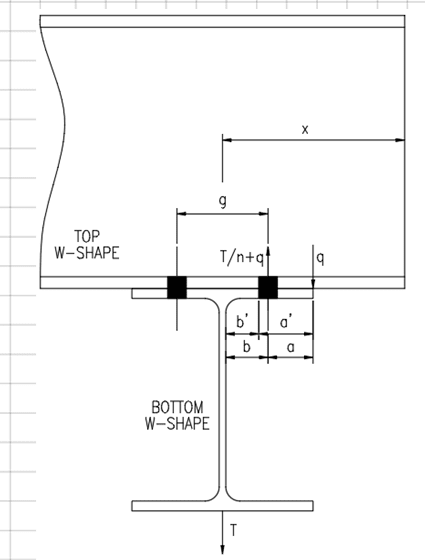Ideastatica Results with some minor commentary
-70x70 square bolt pattern
-Thin = 200UB22 (7mm thick flange)
-Thick = 200UC60 (14.2 thick flange)
-XThick = 200UC60 (custon 40mm thick flange)
Thin-Thin-90deg - 156% (excess prying force of axial load, total bolt load 256% of axial load)
Thin-Thin-0deg - 124%
Thick-Thick-90deg - 16%
Thick-Thick-0deg - 33%
Thick-Thin-90deg - 92%
Thick-Thin-0deg - 90%
XThick-Thin-90deg - 67%
XThick-Thick-90deg - 8%
Commentary:
Three items to note:
-Prying force is largely independent of magnitude of force while deflections and plastic deformation is low (as one would expect)
-The rotation of the members does not have a consistent effect and can be +ve, or -ve on prying force depending of the magnitude. This behaviour is conjectured to be because of the changing fulcrum point and changing stiffneess having different and opposite effects.
-The prying forces are actually observed to be MORE than double for thinner flanges but double for thick flanges. This is conjectured to be because prying is not linear with stiffness.
Interesting results. If you accept these results without to much doubt on the modelling, then
![[bowright] [bowright] [bowright]](/data/assets/smilies/bowright.gif)
congratulations
![[bowleft] [bowleft] [bowleft]](/data/assets/smilies/bowleft.gif)
for those who said the forces double. A good learning point for those who had the incorrect answers (MYSELF included).
Regarding the reliability of Ideastatica compared to AISC, refer to the document below:
[URL unfurl="true"]https://assets-us-01.kc-usercontent.com/1ca05609-4ad1-009e-bc40-2e1230b16a75/8fcf6e15-47a1-480e-aecb-50d4b1a0b33d/T-stub-prying_forces.pdf[/url]
The results of the force acting on a bolt including prying force of IDEA StatiCa generally lies between
the analytical approach using geometrical values of a and b and recommended approach using
geometrical values of a’ and b’ in formulas for bolt forces including prying forces. Therefore, the
magnitude of prying forces is slightly overestimated in IDEA (by cca 10 to 15 % compared to
recommended approach), which is conservative.


![[smile] [smile] [smile]](/data/assets/smilies/smile.gif) )
)![[wink] [wink] [wink]](/data/assets/smilies/wink.gif)

![[bowright] [bowright] [bowright]](/data/assets/smilies/bowright.gif) congratulations
congratulations![[bowleft] [bowleft] [bowleft]](/data/assets/smilies/bowleft.gif) for those who said the forces double. A good learning point for those who had the incorrect answers (MYSELF included).
for those who said the forces double. A good learning point for those who had the incorrect answers (MYSELF included).